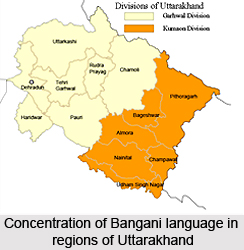 Bangani language is a popular Indian language, mainly spoken in the area of Bangan, which lies in the westernmost Garhwal in the state of Uttarakhand. The region Bangan is located in the border to the state of Himachal Pradesh. It comprises a long ridge from south to north, which is enclosed by the Tons River. There are several dozen villages in Bangan, but the exact size of its population is unknown. Bangani language belongs to the family of Indo Aryan languages. Bangani language basically belongs to the Western Pahari subgroup of the Indo Aryan language family. The dominant group of this region are the Rajputs, followed by the low-caste Koltas. There are only few Brahmans and members of artisan-castes. Devals are low-caste specialists for the transmission of much of Bangani oral literature. Further, there exists no written literature in Bangani language.
Bangani language is a popular Indian language, mainly spoken in the area of Bangan, which lies in the westernmost Garhwal in the state of Uttarakhand. The region Bangan is located in the border to the state of Himachal Pradesh. It comprises a long ridge from south to north, which is enclosed by the Tons River. There are several dozen villages in Bangan, but the exact size of its population is unknown. Bangani language belongs to the family of Indo Aryan languages. Bangani language basically belongs to the Western Pahari subgroup of the Indo Aryan language family. The dominant group of this region are the Rajputs, followed by the low-caste Koltas. There are only few Brahmans and members of artisan-castes. Devals are low-caste specialists for the transmission of much of Bangani oral literature. Further, there exists no written literature in Bangani language.
There are several salient features of Bangani language. The major characteristics of this language comprise preservation of two voiceless sibilants. Like for instance, it includes preservation of s (dental) and s (post palatal). It also comprises preservation of old consonant clusters. Like for instance, rk, br, pr, tr, dr, gr, st. These are traces of r-metathesis, but they do not seem to be typical for Bangani language. The old consonant clusters are especially well preserved inside words. In word-initial position there is a strong tendency for `svarabhakti`. The third salient feature of Bangani language is the conservation of medial `m`. It also includes preservation of geminates together with preceding short vowel. There is no `h` and there are no aspirated voiced occlusive in Bangani language. The class of occlusive and affricated comprises six articulator positions.
Regarding the vocabulary, Bangani language shows some peculiarities which do not have any proper explanation. Both in colloquial speech and in oral literature, words from Sanskrit language are used. However, the circumstances of their origin are unclear. Additionally, there are several dozen words in Bangani language whose etymologies seem to be Indo-European but non-Indo-Aryan. In comparison with the entire vocabulary, however, these two `layers` make up only a few per cent. The problems posed by the Sanskrit words have to do with historical phonology and morphology. Like other languages of India, Bangani also uses the possibility of deviation from a normal or basic word order for expressing specific meanings. In this language, there exists a `permitted` range of such deviations in colloquial speech, which are usually motivated by communication needs. Moreover, there also exists other, and sometimes, more drastic deviations, which are motivated by aesthetic considerations.



















